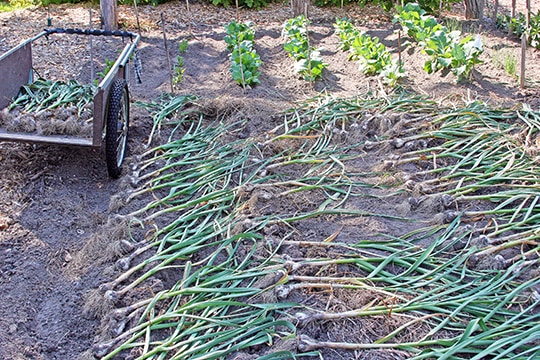
In the early spring the garlic plants practically leap out of the ground! It’s very satisfying to see these when nothing else in the vegetable garden is showing much growth yet.
The garlic (Allium sativum) commonly used to flavor food around the world and has traditionally been utilized medicinally as well. Fortunately, it’s one of the easiest edible plants to grow. To be successful growing garlic you just need a few helpful tips.
- In general it’s better to buy “seed garlic” instead of planting the cloves that are sold for cooking in supermarkets. Those in northern climates (USDA zone 5 and below) will have most success with “hardneck” varieties.
- Buy your seed garlic at a garden center or online but place your order in August. Many sources sell out early! Store your seed garlic in a cool place until time to plant.
- Garlic is planted in the fall and harvested in early to mid-summer depending on your region. You’ll want to plant garlic after your first frost but well before the ground starts to freeze.
- The seed garlic will come in one large head. You’ll need to gently break this down into individual cloves just before planting. Save the few smallest pieces for cooking and plant the biggest cloves in the garden.
- Plant garlic in full sun and well-drained soil.
- Use a hoe to make a shallow trench in your garden. In warmer climates (zone 7 and above) that trench can be about 2 inches deep. In colder areas dig a row 3 to 4 inches in depth.
- Studies show that planting garlic cloves too close together makes for a smaller crop. A good distance to space them is about 6” apart.
- Place the garlic cloves in the trench with the pointy end more or less up. Don’t worry if they fall over as you push the dirt over them.
- Your garlic will probably sprout before the winter – you don’t have to protect it unless you live where the temperatures go well below zero for long stretches. If this is the case, a light, fluffy mulch such as pine needles or straw would be helpful. Be sure to remove this mulch early in the springtime so that the ground warms up quickly.
- In the early summer your garlic will form the start of flowers that we call “scapes.” Most people cut these off when they are small so that all the plant’s energy goes into making bigger heads of garlic. These small scapes are edible and add a mild garlic flavor to your cooking. I have to confess I often leave a few plants with the scapes on because I like their curvy, whimsical appearance.
- When the garlic plants start to yellow slightly, it’s time to harvest! Pull them out of the ground and put them out of the sun and weather to dry. Wait until they’ve dried for a couple of weeks before cutting off the stalks and roots. After these are trimmed put on a clean pair of garden gloves and wipe off the dirt before storing.
- Think of it: a plant that’s tasty, not bothered by animals or insects, and you can put it in the garden in autumn when other crops are finished. What’s not to love? Come to think of it, GarlicLine does have a certain ring to it…

In a warm year we harvest our garlic in late June here in Massachusetts, but in a normal season we pull them in July. After drying in the garden for most of the day the plants are piled in the cart and brought into the garage. NOTE: the garage reeks of garlic for a few days. A small price to pay for such a harvest.

Garlic scapes can be used in soups, omlettes, fritatas (as above), or anywhere you might use green onions. Be sure to harvest the scapes when they are around 6″ long because the smaller they are, the more tender and tasty you’ll find them.
“Tomatoes and oregano make it Italian; wine and tarragon make it French. Sour cream makes it Russian; lemon and cinnamon make it Greek. Soy sauce makes it Chinese; garlic makes it good.” Alice May Borck in The Alice’s Restaurant Cookbook

